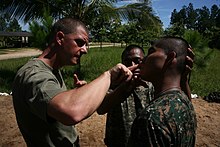This article has multiple issues. Please help improve it or discuss these issues on the talk page . (Learn how and when to remove these messages)
|
| Pressure point (穴位) | |||||||||||||||||||||||||||
|---|---|---|---|---|---|---|---|---|---|---|---|---|---|---|---|---|---|---|---|---|---|---|---|---|---|---|---|
 | |||||||||||||||||||||||||||
| Chinese name | |||||||||||||||||||||||||||
| Chinese | 穴位 | ||||||||||||||||||||||||||
| |||||||||||||||||||||||||||
| Japanese name | |||||||||||||||||||||||||||
| Kanji | 急所 | ||||||||||||||||||||||||||
| Kana | きゅうしょ | ||||||||||||||||||||||||||
| |||||||||||||||||||||||||||
| Part of a series on |
| Alternative medicine |
|---|
 |
Pressure points [a] derive from the supposed meridian points in Traditional Chinese Medicine, Indian Ayurveda and Siddha medicine, and martial arts. They refer to areas on the human body that may produce significant pain or other effects when manipulated in a specific manner. [1]
